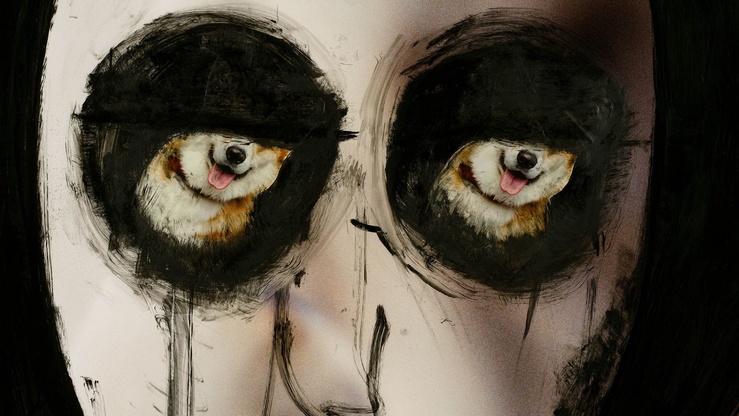
Huma Bhabha — Galerie David Zwirner, Paris
Expansive, inhabited, erudite, visceral, and as full of humor as it is of gravity, Huma Bhabha’s Distant Star exhibition at David Zwirner gallery checks all the boxes of a successful total installation. Conceived as a scenography both archaic and futuristic, the show features six sculptures and a series of monumental drawings in which the Pakistani-American artist explores new materials—such as cast iron and wet clay—while continuing her longstanding practice of formal distortion, central to her visual language for decades.
Flanking the humanoid sculptures are portraits with piercing stares—made of ink and collage layered over the artist’s own photographs—where only the eyes, encircled in black, emerge from the indistinct faces under hoods. These hybrid figures—saints, Franciscan monks, or contemporary avatars clad in hoodies—oscillate between martyrdom and self-preservation. Their ambiguous presence haunts the exhibition space, weaving a fragile thread between religious iconography, post-apocalyptic imagery, and representations of resilience.
By synthesizing elements from both so-called “primitive” arts and science fiction—between totem and taboo (one can hardly miss the shadow of H.R. Giger hovering over the works)—and between conceptual strength and the essential intensity of the gesture, the ensemble presents undeniable coherence.
The sculpture Distant Star (2025), which lends its title to the exhibition, embodies this tension: a monumental cast-iron figure, seemingly frozen in eternal waiting, already marked by oxidation. It reminds us that for Bhabha, one of the sculptor’s primary tools is time—not only as a physical agent of transformation but also as a field for mental projection. The piece stands like a motionless beacon, radiating a solemnity that verges on paralysis. This coherence, impressive as it may be, might nevertheless leave a subtle sense of disappointment in some viewers. As though perfectly controlled, every rough edge seems absorbed into an architecture so thoroughly thought through that it eludes its own vulnerability—a curious counterpoint to the notably new technical gestures introduced here by the artist.
Too precise, too finely calibrated, the exhibition evades any potential criticism through its impressive layering of symbols and meaning (from animal skulls to polystyrene, from personal mythology to universal archaeology). This new body of work—by an artist who, in any case, has nothing left to prove—resists any value judgment, yet struggles to guide us down a path, however fragile, that we might make our own. The viewer is summoned but never truly unsettled.
This Parisian exhibition—Bhabha’s first solo show in the city since 2009—arrives at a moment of well-deserved international recognition. It coincides with Encounters: Giacometti at the Barbican Centre in London, a striking curatorial dialogue that highlights the extraordinary strength of her work when confronted with other singularities. There, one can read her unique approach to mutilating as much as grafting the human figure in order to conceive it as infinitely plural, estranged from itself.
The precision of the exhibition, its visual clarity that oscillates between attraction and repulsion, and its post-historical intelligence (it feels almost like stepping into a main pavilion at a 2000s Venice Biennale) ultimately conceal the experimental edge and radical engagement that might have provided the ideal imbalance—so necessary to truly fall under the spell of these distant beings, and to integrate them, in turn, into our own imaginary.
Huma Bhabha, Distant Star — Galerie David Zwirner, 108, rue Vieille du Temple, 75003 Paris — June 13—July 26, 2025 Read more










